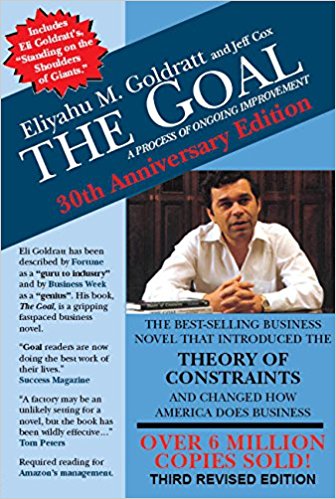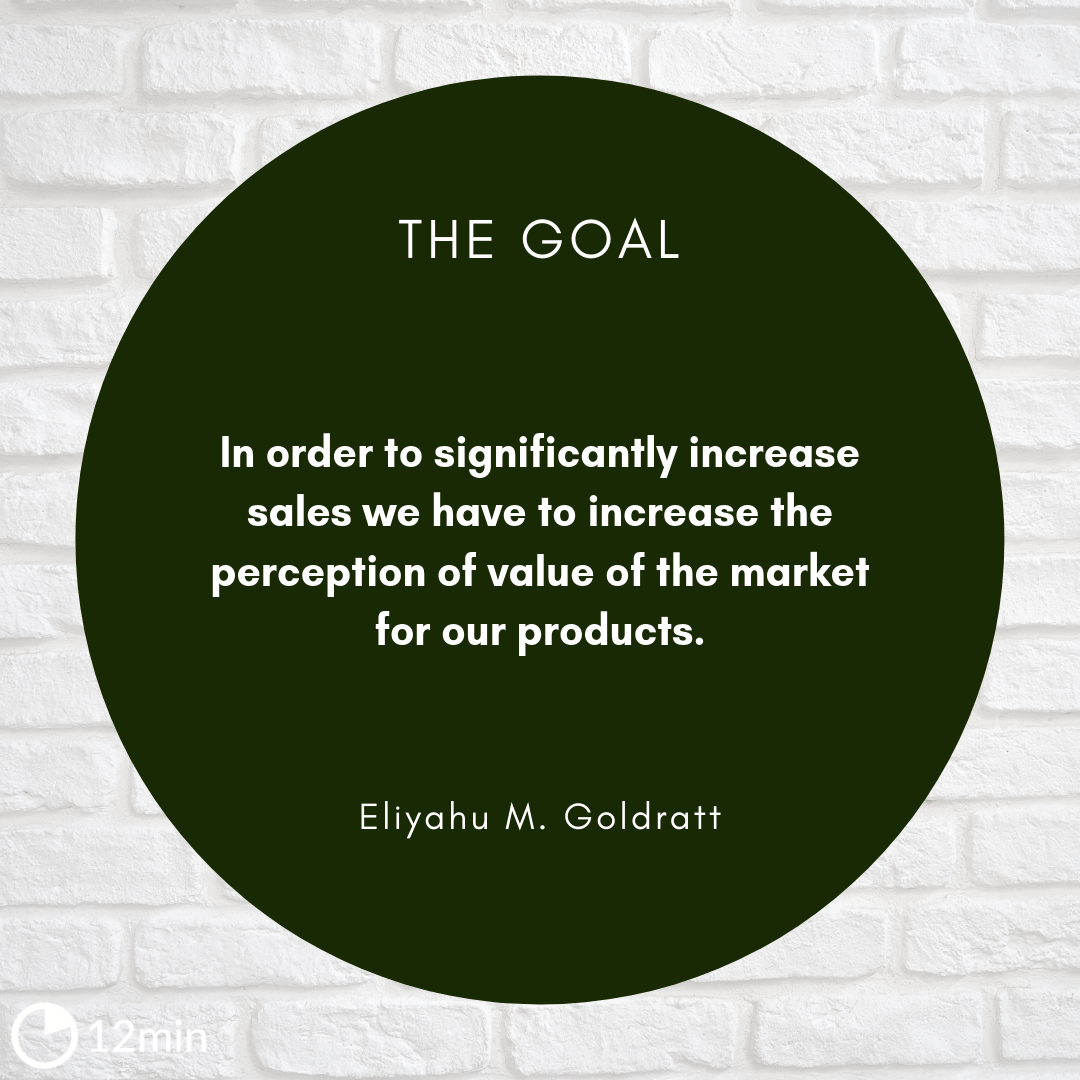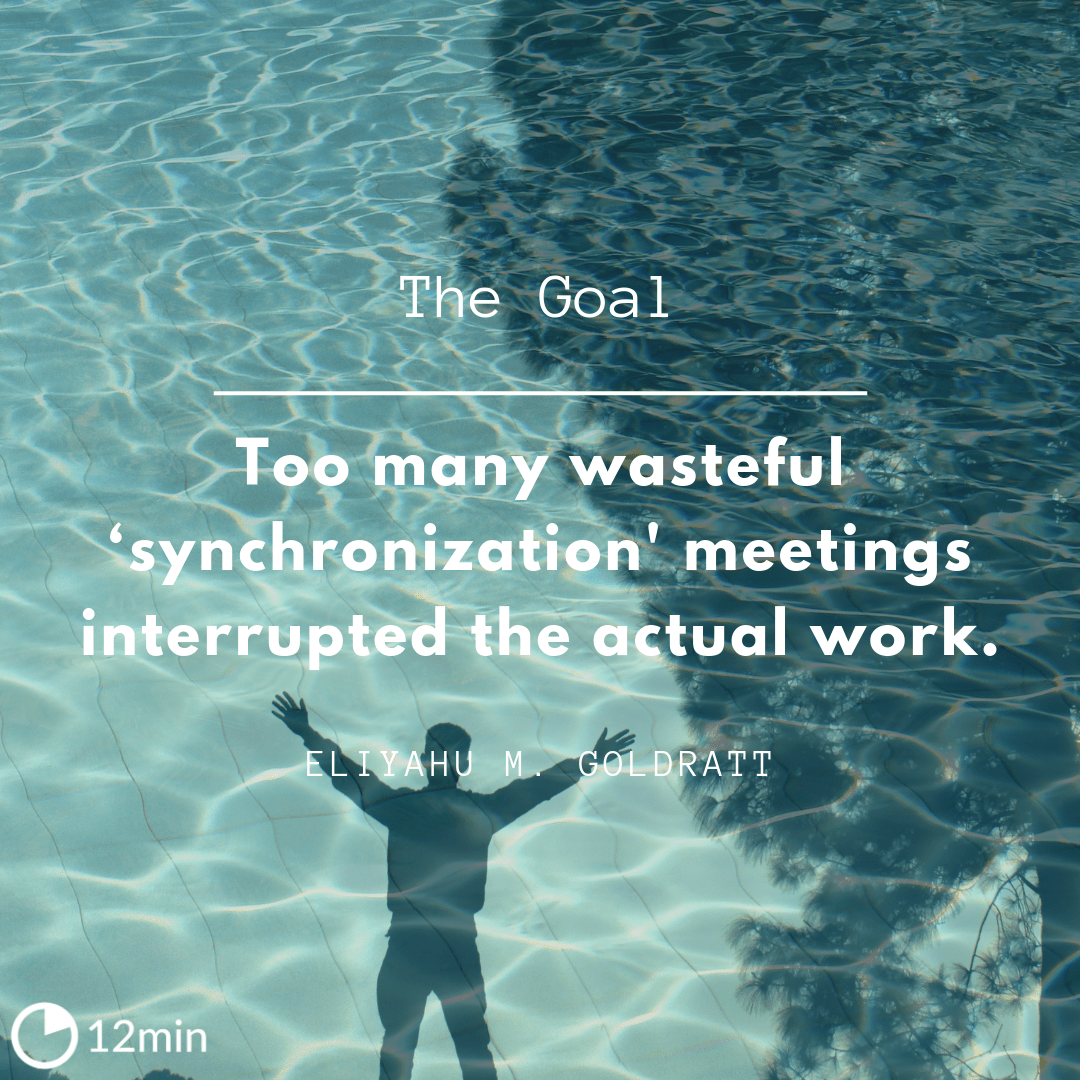The Goal Summary

9 min read ⌚
Quick Summary: In The Goal, Eliyahu Goldratt examines practically and realistically all the main concepts of industry, always seeking to find the solution of problems through the use of bottleneck theory. His educational approach is so respected that it has become a must-read in hundreds of major colleges and universities in business, administration, and engineering.

Delays in production, declines in revenue, and other problems that companies face are gradually resolved in this management parable.
Also, the fundamental concepts of the Theory of Constraints have been popularized by this work.
In this microbook, you will learn how to overcome the bottlenecks of your company and put into practice a process of continuous improvement. Let’s go?
The Goal Summary
Eliyahu M. Goldratt was a physics student in Israel in the 1970s. There he developed a mathematical theory for industries to plan their production optimally. The theory became known as OPT (Optimized Production Technology).
After completing his studies, Goldratt devoted himself to putting his theory into practice in the marketplace in real companies, and in the 1980s he expanded this theory by formulating the so-called Restriction Theory.
The theory of constraints reveals that in order to maximize a firm’s productive capacity, it is necessary to create mechanisms that assess how production line decisions affect profits.
Not always the volume of profits of a company is directly associated with its efficiency.
Being productive means being closer to the expected result of the goal. Any action that brings the company closer to its goal is therefore productive. To measure a company’s performance, you need to use financial metrics.
The Company Goal
A for-profit company should seek present and future profitability. Unlike previous thought currents, Goldratt believes that profitability does not conflict with the company’s mission and vision.
Profitability ensures that the company can grow and become sustainable to stay in the market and that is what enables the company’s mission to be realized.
The survival of a company derives from its ability to generate value and profits and this is done when its products and services generate value for the consumer.
Consumer needs for quality and functionality need to be met for the company to continue growing.
Welcome To The Unique Manufacturing World
Alex Rogo is the manager of a UniCo manufacturing plant. Its factory is running the risk of being closed by the UniCo directors. The factory is failing to deliver the products consumers want, and this brings permanent losses.
Production is lagging behind, employees are trying to catch up by working overtime, and everyone is tired and stressed out. Combined delays, worn out employees and overtime cost prevent the factory from generating money.
Without alternatives, Rogo seeks outside help. He hires a consultant named Jonah, to find improvement opportunities and save the factory.
Playing Catch Up
As the manufacturing and customer orders delivery is late, Jonah needs to reduce the time between the order made by a customer and the delivery of the product.
To reduce this time, called lead time, from a few months to a few weeks, Jonah goes on to try to understand what may be stopping the factory from becoming profitable.
He realizes that although the factory is not generating money, it has teams that celebrate success by breaking their individual goals.
Teams that had independent goals and were responsible for some steps in the process were succeeding.
Because teams work together in the factory, a high-productivity team that hits the finish line at the right cost and ends up generating more inputs for other teams, which ended up stopping the manufacturing process.
That makes it clear to Rogo and Jonah that the high productivity of a team is not necessarily a good thing for the plant as a whole.
The integration of the teams functions as a pipeline where a constant flow of activities occurs. If a team cannot keep up with another team’s performance, it becomes a bottleneck for the company and this pipeline flow capacity decreases.
Products stand still in the middle of the process, the inventory grows unnecessarily, and resources invested by the company come to a standstill. Rogo’s factory, for example, bought raw materials at high speed to keep up with the first team.
However, the company was unable to deliver the products because many incomplete products would stand still after the first stage completion.
Two Types Of Resources
There are 2 types of resources in a factory:
- The bottleneck resource: This is the type of resource whose supply is equal to or less than its demand, like the team that could not deliver and ended up stopping the manufacturing process;
- The non-bottleneck resource: Any other resource whose capacity is greater than its demand, as the first team that delivered more inputs in the production line than the factory could follow.
Alex Rogo implemented a change by understanding the two types of resources. The company’s processes need to be aligned with the company’s goal of generating profits, and the teams need to change focus.
When the highly productive team delivers more than the production line can absorb, resources stand idle, and the company’s overall goal is undermined.
So the first task is to identify the company goal (make the plant profitable) and have all teams work toward the same goal.
If a team does a local performance optimization and this goal does not help the company achieve its goal, this is not a positive optimization.
Company Goal Components
Together, Jonah, Alex, and his team set out to identify how to improve their production process. To reach the financial goal, they discovered that there are 3 tasks to be accomplished:
- Reduce operational expenses: These expenses represent all the money the system spends to turn inventory into earnings, that is, products sold. They include all the money that the system spends on something that cannot be saved for a future.
- Reduce inventory of stationery products: You must always keep in stock the minimum of undelivered products and fixed expenses. Inventory is all the money that the system invested in buying things that the company intends to sell but has not yet sold. Inventory includes raw materials stock, products in process, finished products and still other assets as machines and the factory space itself.
- Increase company earnings: Earnings are the products converted into cash, that is, the revenues generated by the factory work. An important point is that production is not necessarily earned while the product is not sold. The gain corresponds to the selling price less the amount paid to the suppliers for the direct raw materials. It does not matter when inputs have been purchased.
By acting on these 3 components, the factory could then reach profitability and the indicator to be tracked is net profit. It is measured by the difference between earnings, defined as sales revenues less operating expenses and inventory costs.
Net income reflects how much money the company is generating at any given time.
Another important indicator of being monitored is the return on investment. It exists to measure the effort required to achieve predefined profitability.
To know your return on investment, you must divide the net profit by the inventory, that is, all the money that the company invests in the purchase of things that it intends to sell.

Identifying Bottlenecks
Alex Rogo and Jonah then left to identify the company bottlenecks, the stages of the production line where the process stopped.
Once there are 2 teams causing bottlenecks, they impact the entire factory to produce at the slower bottleneck speed.
Thus, employees would only work if it was possible to deliver the product to the customer at the factory speed. When work generates inputs that are not going to be used, what actually occurs is a waste and is not advantageous to the company.
By optimizing the factory bottleneck processes, they realized that it was not necessary to focus on the processes that worked.
If the focus is on the bottleneck, it’s easy to increase factory productivity. Any effort in non-mitigating processes did not produce results.
These teams did not need the pressure, overtime or bigger investments to work, after all, any gain about them did not help the company’s performance.
Even the purchase of computers and robots to improve processes without bottlenecks was useless and mere waste.
Market’s Bottleneck
With factory speed improving, the team can deliver products to the market in a timely manner. On the other hand, a new problem arises.
There is not so much demand to buy the products created by the factory’s high production capacity.
When capacity is greater than demand, problems arise. Ready-made products get stuck in inventory, and that means stationary money, which detracts from the goal.
That’s why Alex’s new priority is to align factory capacity with market demands.
The factory needs to be pulled from the market so that what it produces costs as little as possible to generate more gains. When the process is pulled from the market, there is no waste.
Adopting Continuous Improvement
To stay competitive, UniCo needs to reduce lead time, costs to deliver the product and thus ensure that the plant is profitable.
The easiest way to keep the plant efficiency is adopting a method of continuous improvement so that as time goes by the factory becomes more and more optimized.
The process of continuous improvement consists of 5 main steps:
- Identify system constraints: In this first step, the system constraints must be identified. The entire system must have at least one constraint but will usually have a very small number of constraints. In The Goal, Goldratt suggests that policies within organizations may also be included among constraints, which, however, are not easily identified since they are embedded in the organizational culture;
- Decide how to exploit system constraints: Exploring system constraints mean getting the most out of them, that is, getting the best result possible within that condition. For example, if the constraint is the market, ie, production capacity is above market demand, one way to exploit this constraint is to deliver 100% of orders on time. Another example: assuming that the restriction is the availability of a machine, exploiting this restriction means manufacturing the products that generate the best result in each hour worked or increasing the number of shifts in operation;
- Subordinate anything else to the previous decision: Restrictive resources or bottlenecks determine the organizations gain. If a non-restrictive resource is working at a rate higher than the constraint, there will be an increase in inventories. Therefore, all non-restrictive resources must be used to the exact extent required by the way in which restrictions are exploited;
- Raise System Restrictions: Restrictions limit the ability of the company to continue to improve its performance and therefore must be minimized or eliminated. Steps two and three are designed to improve efficiency by making the best use of scarce resources available. If, after the third step, some constraint remains, the restriction must be raised or exceeded, adding a greater amount of scarce resource to the system. Missing machines? Buy machines. Missing people? Hire. The constraint will be broken, and the company’s performance will rise to a certain limit when it will be limited by some other factor, and the constraint is changed.
- Revaluation: If the constraint is broken in the previous steps, return to step 1, but do not let inertia become a system constraint. A new restriction will always appear after the fourth step, and the cycle must be restarted from the first step. An important recommendation is that inertia does not become a system constraint. Inertia within organizations generates political constraints, that is, in many situations, there may be no physical constraints on production capacity, material volume or market demand, but the system operates inefficiently due to internal production policies and logistics.
Through continuous improvement, Alex and his team can reduce lead time, reduce costs and prove their method to top management so they can save the plant.
This turnaround allowed Rogo, previously tired and stressed, to be promoted and invited to apply his apprenticeships in all UniCo factories.
Like this summary? We’d Like to invite you to download our free 12 min app, for more amazing summaries and audiobooks.
The Goal Quotes
What you have learned is that the capacity of the plant is equal to the capacity of its bottlenecks. Share on X The Goal Summary Share on X The entire bottleneck concept is not geared to decrease operating expense, it’s focused on increasing throughput. Share on X They’re measurements which express the goal of making money perfectly well, but which also permit you to develop operational rules for running your plant. Share on X The minute you supply a person with the answers, by that very action you block them, once and for all, from the opportunity of inventing those same answers for themselves. If you want to go on an ego trip, to show how smart you are, give… Share on XFinal Notes
In a company, it is important that work is organized to identify bottlenecks. Once identified, we must focus entirely on solving it and even adjusting other processes to operate according to their capacity.
All this can be achieved through a process of continuous improvement, always monitored and optimized to align the company more and more with the market demand.








